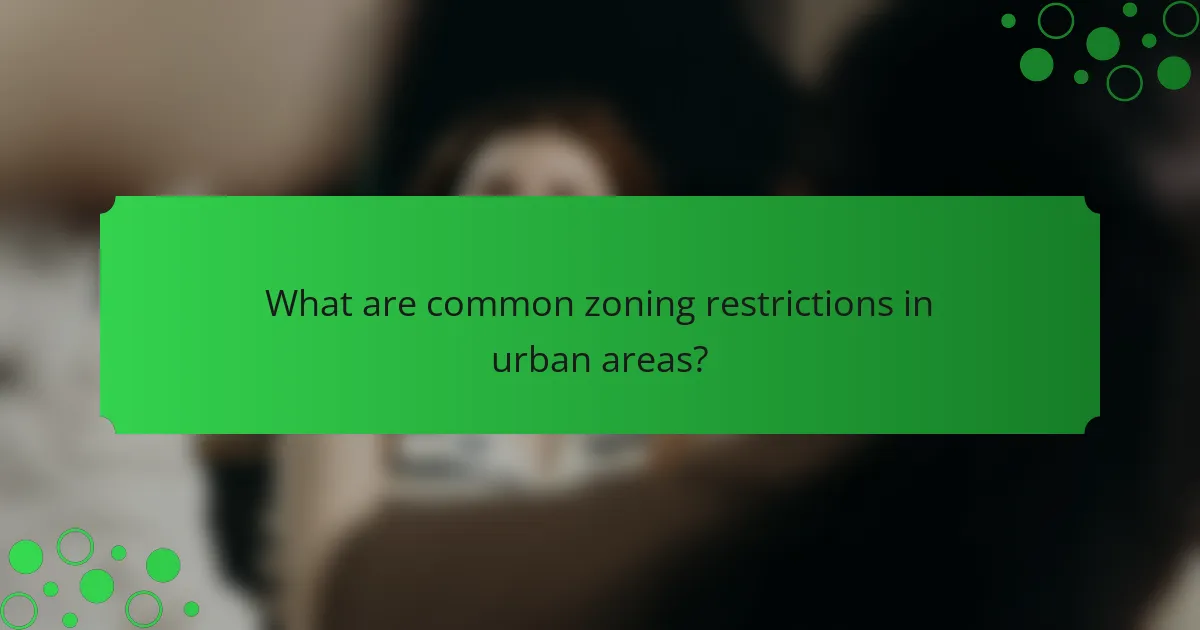Zoning laws play a crucial role in shaping land use in urban areas, dictating how properties can be developed for residential, commercial, or industrial purposes. Understanding these regulations is essential for property owners to ensure compliance and protect their investments. In some cases, property owners may seek zoning variances, which allow for deviations from standard regulations when a legitimate need is demonstrated.

What are common zoning restrictions in urban areas?
Common zoning restrictions in urban areas dictate how land can be used, impacting residential, commercial, and industrial developments. These regulations ensure organized growth, protect property values, and maintain community standards.
Residential zoning laws
Residential zoning laws primarily regulate the types of housing allowed in specific areas, including single-family homes, multi-family units, and townhouses. These laws often dictate minimum lot sizes, building heights, and setbacks from property lines to ensure adequate space and privacy.
For example, in many urban neighborhoods, single-family homes may require a minimum lot size of around 5,000 to 10,000 square feet, while multi-family zones might allow for higher density with smaller lot sizes. Homeowners should check local regulations to understand the specific requirements in their area.
Commercial zoning regulations
Commercial zoning regulations govern the types of businesses that can operate in designated areas, influencing everything from retail stores to offices. These regulations are designed to separate commercial activities from residential areas to minimize disturbances and maintain property values.
In urban settings, commercial zones may be classified into categories such as neighborhood commercial, regional commercial, or central business districts, each with its own set of permissible activities. Business owners should verify zoning classifications to ensure compliance before establishing operations.
Industrial zoning limitations
Industrial zoning limitations define where manufacturing, warehousing, and other industrial activities can occur. These areas are typically located away from residential zones to reduce noise, traffic, and pollution impacts on nearby communities.
Common industrial zones may include light industrial, which allows for less intensive operations, and heavy industrial, which accommodates more significant manufacturing processes. Companies should assess local zoning maps to identify suitable locations for their industrial activities.
Environmental zoning constraints
Environmental zoning constraints protect natural resources and ecosystems by restricting development in sensitive areas such as wetlands, floodplains, and habitats for endangered species. These regulations aim to preserve biodiversity and mitigate environmental impacts.
For instance, in many urban areas, certain zones may prohibit construction within a specified distance from water bodies or require environmental impact assessments before any development. Developers must engage with local environmental regulations to ensure compliance and avoid potential fines.
Height and density restrictions
Height and density restrictions control how tall buildings can be and how many units can be constructed on a given lot. These regulations help maintain the character of neighborhoods and prevent overcrowding in urban areas.
For example, a residential zone might limit building heights to two or three stories, while a commercial zone could allow taller structures. Density restrictions may specify the maximum number of units per acre, influencing housing availability and affordability. Property developers should consult local zoning ordinances to understand these limitations and plan accordingly.

How to ensure compliance with zoning laws?
To ensure compliance with zoning laws, familiarize yourself with the specific regulations that apply to your property. This involves understanding local ordinances, consulting with professionals, and utilizing available resources to confirm that your plans align with zoning requirements.
Understanding local zoning ordinances
Local zoning ordinances dictate how land can be used in a specific area, including residential, commercial, and industrial classifications. Each municipality typically has its own set of rules, which may include restrictions on building height, lot size, and land use. Familiarizing yourself with these ordinances is essential to avoid violations.
Check your local government’s website or zoning office for accessible documentation. Many areas provide maps and guides that outline zoning districts and their respective regulations, making it easier to understand what is permissible in your location.
Consulting with zoning attorneys
Engaging a zoning attorney can provide expert guidance on navigating complex zoning laws and regulations. These professionals can help interpret local ordinances, assess your compliance, and represent you in any disputes or variances you may need to pursue.
When selecting a zoning attorney, look for someone with experience in your specific area or type of zoning issue. Their insights can save you time and help you avoid costly mistakes related to zoning compliance.
Utilizing zoning compliance checklists
Zoning compliance checklists are practical tools that can help you ensure that your project meets all necessary regulations. These checklists typically include items such as verifying land use, checking setback requirements, and confirming building permits.
Consider creating a customized checklist based on your local zoning ordinances. This can streamline the compliance process and serve as a reference throughout your project, helping you stay organized and focused on meeting all legal requirements.

What are zoning variances and how to obtain them?
Zoning variances are exceptions to existing zoning laws that allow property owners to use their land in a way that deviates from the standard regulations. To obtain a variance, applicants must demonstrate a legitimate need and follow a specific application process set by local authorities.
Definition of zoning variances
A zoning variance permits a property owner to deviate from specific zoning regulations, such as setbacks, height restrictions, or land use. These variances are typically granted when strict adherence to zoning laws would cause undue hardship or practical difficulties for the property owner.
For example, if a homeowner wants to build a garage closer to the property line than the zoning ordinance allows, they may apply for a variance to obtain permission for this modification.
Steps to apply for a variance
The process for applying for a zoning variance generally involves several key steps. First, the applicant must gather necessary documentation, including site plans and a statement explaining the need for the variance. Next, they must submit an application to the local zoning board or planning commission.
After submission, a public hearing is typically scheduled, allowing neighbors and community members to voice their opinions. Following the hearing, the zoning board will make a decision, which may include conditions that must be met for the variance to be granted.
Criteria for granting variances
Zoning boards evaluate several criteria when considering a variance application. Common factors include whether the variance is necessary due to unique circumstances of the property, whether it will negatively impact surrounding properties, and if it aligns with the community’s overall zoning goals.
For instance, if the property has unusual topography that makes compliance with zoning laws impractical, this may be a valid reason for granting a variance. Applicants should be prepared to provide evidence supporting their case to increase their chances of approval.

What are the consequences of zoning law violations?
Zoning law violations can lead to significant consequences, including financial penalties, legal actions, and a decrease in property value. Understanding these repercussions is essential for property owners to ensure compliance and protect their investments.
Fines and penalties
Property owners found in violation of zoning laws may face fines that can range from hundreds to thousands of dollars, depending on the severity of the infraction and local regulations. In some jurisdictions, repeat offenders may incur higher penalties or daily fines until compliance is achieved.
Additionally, municipalities may impose administrative fees for processing violations, which can add to the overall financial burden. It’s crucial for property owners to be aware of their local zoning ordinances to avoid these costs.
Legal actions and lawsuits
Zoning violations can lead to legal actions initiated by local governments or affected neighbors. These actions may include cease and desist orders, which require the property owner to halt any non-compliant activities immediately.
In some cases, property owners may face lawsuits seeking damages or injunctive relief, which can result in costly legal fees and prolonged disputes. Engaging with legal counsel familiar with zoning laws can help mitigate these risks.
Impact on property value
Violating zoning laws can negatively affect property values, as potential buyers may be deterred by the risk of fines or legal issues. Properties with unresolved zoning violations may sell for significantly less than comparable properties in compliance with local regulations.
Moreover, ongoing violations can lead to a negative perception in the community, further diminishing the property’s marketability. Property owners should prioritize compliance to protect their investment and maintain property value.

How do zoning laws differ across states?
Zoning laws vary significantly across states, reflecting local priorities, land use needs, and community values. Each state has its own set of regulations that dictate land use, building codes, and property development, leading to diverse approaches to zoning issues.
Variations in California zoning laws
California zoning laws are known for their complexity and emphasis on environmental protection. Many cities implement strict regulations to manage urban growth, preserve open spaces, and address housing shortages. For instance, the California Environmental Quality Act (CEQA) requires environmental reviews for new developments, influencing zoning decisions.
Local jurisdictions often adopt specific zoning ordinances that cater to their unique demographics and geography. This can result in a mix of residential, commercial, and industrial zones, with some areas designated for mixed-use development to promote walkability and reduce traffic congestion.
Differences in New York zoning regulations
New York’s zoning regulations are characterized by their focus on density and land use diversity, particularly in urban areas like New York City. The city employs a comprehensive zoning resolution that dictates building heights, bulk, and use types, aiming to manage population density and urban infrastructure effectively.
In addition to standard zoning categories, New York offers special districts that allow for tailored regulations, such as the Special Hudson Yards District, which encourages high-density development while addressing infrastructure needs. Property owners must navigate these complex regulations to ensure compliance and maximize development potential.
Texas zoning law overview
Texas has a more decentralized approach to zoning, with many cities opting for minimal regulations compared to states like California or New York. While some urban areas, such as Austin and Houston, have established zoning laws, many smaller cities operate without formal zoning, relying instead on land use planning and subdivision regulations.
This lack of stringent zoning can lead to mixed-use developments and a more flexible property market. However, property owners should be aware of local ordinances and building codes, as these can vary widely even within the same state, impacting development opportunities and compliance requirements.

What resources are available for understanding zoning laws?
Understanding zoning laws is crucial for property owners and developers. Key resources include local government websites, legal databases, and community planning offices that provide detailed information on zoning regulations and compliance requirements.
Local government websites
Local government websites are primary resources for zoning laws, offering access to ordinances, maps, and guidelines specific to your area. These sites typically provide searchable databases where you can find zoning classifications, permitted uses, and restrictions applicable to your property.
When using these websites, look for sections dedicated to planning and zoning. Many municipalities also publish updates on zoning changes, public hearings, and community engagement opportunities, which can be vital for staying informed.
For example, a city’s zoning page may include downloadable zoning maps and links to relevant forms for variance applications. Familiarizing yourself with these resources can help you navigate compliance and avoid potential legal issues.
